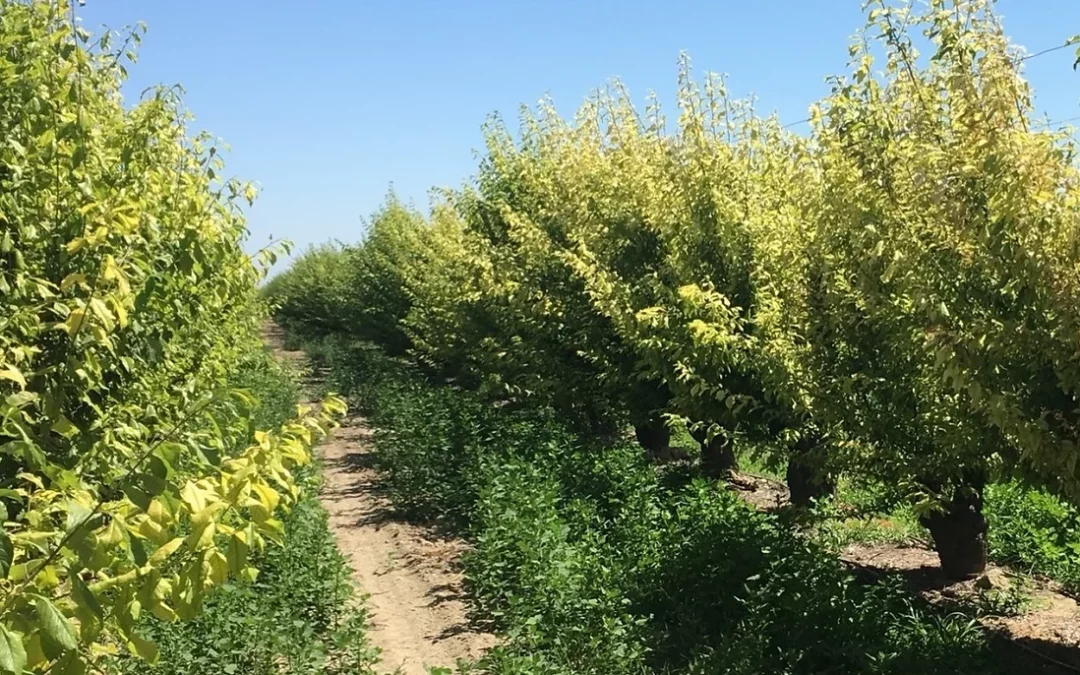Here in Central California, we tend to have very calcareous soils. Calcareous soils have some benefits but often leave farmers struggling with high pH. One of the common problems that occur with high pH is iron deficiency.
Having an iron deficiency can be hard to fix, but is that the problem? The traditional answer has been to use materials like EDTA or EDDHA iron to try and force more into the plant. Iron chelates are typically just a short-term solution causing plants to green up, then turning chlorotic again just a couple of weeks later.
How do we stop treating the symptoms and start to fix the problem? So I ask, is lack of iron the problem, or is it a symptom of standard growing practices? The standard answer for farmers for almost any growing problem over the last 50 years has been “give it more.” More nitrogen will make it green.
More of our new pesticides will kill that bug. More Roundup will get rid of those weeds. More, more, more, more…….. If there is one thing that we have learned from this approach, it is that more is most certainly not the answer that we should have accepted.
Just adding more is an excellent system for the salesman, but not so good for farmers trying to stay profitable. Let’s look at how the plant uses iron and see our options. The use of nitrate and iron is interwoven within commercial crop production. Not because plants need iron to uptake nitrate but because they have to use iron in the nitrate reductase enzyme system to be able to convert nitrate into protein. Protein or amine nitrogen is the form of nitrogen that the plant uses.
This process can account for over 75% of the iron plants have available to them. Not only does nitrate increase the need for iron, it simultaneously decreases the availability of iron compared to other forms of nitrogen. Amine (NH2) and ammonium (NH4) forms of nitrogen do not require iron when converting to protein in the plant.
There is also an additional benefit to using amine or ammonium forms of nitrogen when taken up by the plant roots; they will exude a proton (H+). When this happens, it works to release other bound nutrients like iron and manganese in the soil profile.
In a natural setting, plants receive a minimal amount of nitrate, and the soil can release an ample amount of iron corresponding to the growth. This growth is typically slow hence the use and perceived benefits of heavy nitrate applications. Nitrate is the form of nitrogen that not only requires iron to process but also fails to trigger root absorption of iron at the same time.
There is enough total iron in the top six inches of the soil that trees could grow without an iron deficiency for 50 years, but this iron is typically oxidized and not available to the plant. Having a reduced and bio-available form of iron is critical for both plant and soil health.
Many standard farming practices lead to more oxidized soil, including the use of nitrates and sulfuric acid. The ability to unlock and use the iron already in the soil is paramount to the long-term viability of a farming operation. The days of being able to add more to the system every year in perpetuity are long gone.
Limited biological activity is a crucial factor that is often overlooked or taken for granted in most farming operations. There are many benefits to creating an abundant microbiota in your field. Increasing iron availability is just one small benefit.
The most advanced soil inoculants will contain specific strains of biology that are intentionally producing siderophores. Atlas is our product from Axiom Ag that produces an abundance of these enzymes. Siderophores are iron-chelating compounds that are excreted by particular strains of bacteria and fungi. They are very effective at etching iron from the soil. They are also effective at transporting iron across cell membranes. They are amongst the most potent soluble iron-binding agents known to man.
With this healthy biological activity, not only will you be able to etch more micronutrients from the soil, like iron, but these newly available nutrients will hold in the root zone in a bio-available form that the plant can access when needed. When we achieve this, the discussion around pH becomes nearly irrelevant. It doesn’t matter what the pH of the soil is (within reason) if a plant can access all of the nutrients that it requires for optimum growth.

